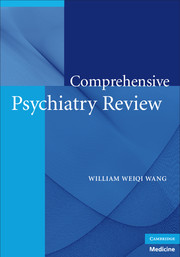Book contents
- Frontmatter
- Contents
- Introduction
- PART I INTELLECTUAL FOUNDATION OF PSYCHIATRY
- PART II EVALUATION AND MEASUREMENT
- PART III PSYCHIATRIC DISORDERS
- 10 Cognitive Disorders
- 11 Addictions: General Consideration
- 12 Addictions: Alcohol-Related Disorders
- 13 Addictions: Nonalcoholic Substance-Related Disorders
- 14 Psychotic Disorders
- 15 Mood Disorders
- 16 Anxiety Disorders
- 17 Somatoform Disorders
- 18 Dissociative Disorders
- 19 Sexual and Gender Identity Disorders
- 20 Eating Disorders and Weight Issues
- 21 Sleep Disorders
- 22 Factitious Disorders and Malingering
- 23 Personality Disorders
- 24 Child and Adolescent Psychiatric Disorders
- 25 Psychosomatic Disorders and Consultation-Liaison Psychiatry
- PART IV PSYCHIATRIC THERAPEUTICS
- PART V NEUROPSYCHIATRY AND RELEVANT NEUROLOGIC CONDITIONS
- PART VI SPECIAL TOPICS
- PART VII REVIEW QUESTIONS
- Bibliography
- Index
20 - Eating Disorders and Weight Issues
from PART III - PSYCHIATRIC DISORDERS
Published online by Cambridge University Press: 18 January 2010
- Frontmatter
- Contents
- Introduction
- PART I INTELLECTUAL FOUNDATION OF PSYCHIATRY
- PART II EVALUATION AND MEASUREMENT
- PART III PSYCHIATRIC DISORDERS
- 10 Cognitive Disorders
- 11 Addictions: General Consideration
- 12 Addictions: Alcohol-Related Disorders
- 13 Addictions: Nonalcoholic Substance-Related Disorders
- 14 Psychotic Disorders
- 15 Mood Disorders
- 16 Anxiety Disorders
- 17 Somatoform Disorders
- 18 Dissociative Disorders
- 19 Sexual and Gender Identity Disorders
- 20 Eating Disorders and Weight Issues
- 21 Sleep Disorders
- 22 Factitious Disorders and Malingering
- 23 Personality Disorders
- 24 Child and Adolescent Psychiatric Disorders
- 25 Psychosomatic Disorders and Consultation-Liaison Psychiatry
- PART IV PSYCHIATRIC THERAPEUTICS
- PART V NEUROPSYCHIATRY AND RELEVANT NEUROLOGIC CONDITIONS
- PART VI SPECIAL TOPICS
- PART VII REVIEW QUESTIONS
- Bibliography
- Index
Summary
The central concern of eating disorders is not about eating, but controlling over physical image. The existence of eating disorders reflects the emotional impact of social pressure to mental condition. Voluntary starvation was reported from ancient times in many cultures. One of the early reports happened around the sixth century BC in China. King Ling of Chu was notorious for his obsession with slim-waisted servants. When King Ling's subordinates realized that thinness was linked to potential of political promotion, starvation quickly became zeal in the court. The kingdom finally crashed out of King Ling's erratic rule, and the King himself committed suicide. Regulating body image with extreme measures was also seen in Victoria era, when obesity was seen as a characteristic of poverty. The phenomenon of voluntary starvation by itself was not viewed as a medical condition until the nineteenth century, when published medical description of anorexia started to appear in France and England. Contemporary societal trend of thinness contributed to escalated prevalence of anorexia nervosa since 1950s, prominently in industrialized countries. Forms of binge eating was also reported for thousands of years, and believed to be more prevalent than anorexia. However, some cases of simple greed for gourmet food may well be slipped in before the establishment of diagnostic criteria.
DSM-IV-TR allows three diagnoses of eating disorders
▶ Anorexia nervosa
▶ Bulimia nervosa
▶ Eating disorder not otherwise specified (NOS)
Obesity is a common and chronic medical condition, but not a psychiatric disorder by itself. It, however, imposes significant emotional distress and often comorbid with mood disturbances.
- Type
- Chapter
- Information
- Comprehensive Psychiatry Review , pp. 143 - 148Publisher: Cambridge University PressPrint publication year: 2009



